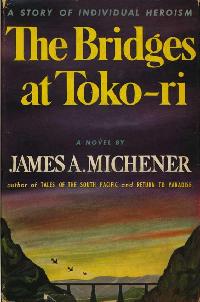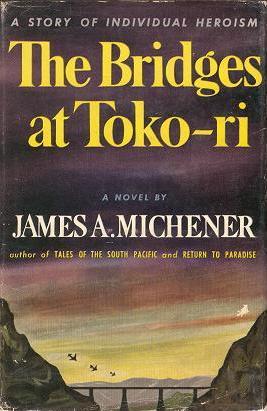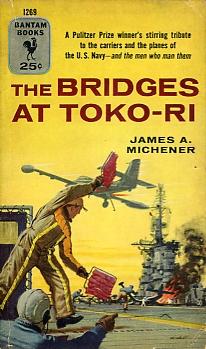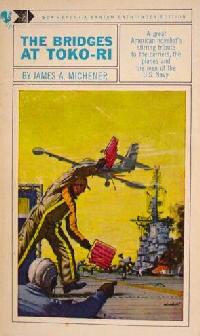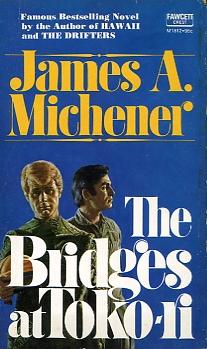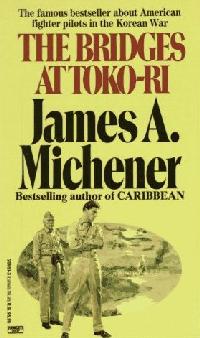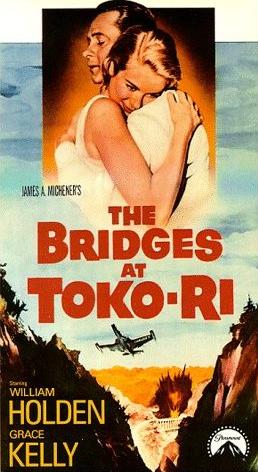The Bridges at Toko-ri
Heroism in Korea, passion in Japan
By William Wetherall
First posted 1 September 2006
Last updated 1 September 2006
James A. Michener Hardcover editionsNew York: Random House, 1953 Paperback editionsNew York: Bantam Books, 1954 New York: Fawcett Crest, 1973 London: Corgi Books, 1969 Cover blurbsThe back cover of Bantam's first paperback edition is both dramatic and provocative.
One has to open the book to meet its main protagonist and glimpse his fate. The Korean WarThe Korean War of the mid 20th century began in the late 19th century when Korea failed to defend itself against Chinese, Russian, and Japanese desires to control its affairs. In 1910 Korea became part of the Empire of Japan, then after Japan's surrender in 1945 the peninsula was occupied north and south of the 38th parallel by the Soviet Union and the United States. The establishment of first the Republic of Korea (ROK) in the south and the Democratic Republic of Korea (DPRK) in the north in 1948, militarily backed by the US and the USSR, made a peaceful reunion between north and south more difficult. Mao Zedong's victory in China in 1949 made a political compromise virtually impossible, given the ideological standoff between the coldwar powers. The Korean War began on 25 June 1950 when DPRK invaded ROK, ostensibly because some ROK troops had earlier crossed the 38th parallel into DPRK territory. The "Korean conflict" quickly became a UN affair, but for all practical purposes it was a war between the United States on the ROK side and the USSR and China on the DPRK side. After a US-led drive to the Yalu that included the capture of Pyongyang, a Chinese counter attack pushed the UN forces back south and recaptured Seoul. Regrouped UN forces then drove DPRK and Chinese troops from Seoul and fought back to the 38th parallel, where the war settled into into a stalemate. An armistice began on 27 July 1953. Half a century, as I write this, DPRK and ROK still patrol a DMZ along the 38th parallel. Many US soldiers remain stationed in ROK -- and at several miliary bases in Japan. Japan was an occupied country when the Korean War began. It did regain its sovereignty until the signing of the San Francisco Peace Treaty in September 1952. US bases in Japan were staging areas for many of America's operations during the Korean War. Japan's economy benefited from opportunities to provide logistical support. US bases in Japan also became extensions of the Vietnam War. Japan still hosts many US military bases, and is otherwise a lynchpin in America's forward deployment of military forces in East Asia and the Pacific. The Bridges of Tokyo-riNortheast Asia -- Korea and Japan -- were the stages for the first two novels Michener wrote after moving to Hawaii in 1949. The Bridges at Toko-ri was first published in June 1953, one month before the cease fire. In barely more than one-hundred pages, Michener narrates an action-packed story of a carrier pilot who sacrifices himself in a hazardous mission to destroy some heavily defended bridges over the Yalu river. Set in both Korea and Japan, the novel is essentially Michener's tribute to the men and operations he witnessed during the weeks he spent on board the carriers USS Essex (CV 9) and USS Valley Forge (CV 45) while they were on missions off the coast of DPRK in late 1951 and early 1952. As finger excercises for the novel, Michener wrote articles like "The Forgotten Heroes of Korea" (The Saturday Evening Post, v 224, n 45, 10 May 1952, pp 19-21, 124-128) about navy carrier pilots, and "All For One: A Story From Korea" (Readers Digest, v 61, n 363, July 1952, pp 1-2) about an air rescue attempt from the USS Valley Forge. American magazines carried numerous reports of relations between US servicemen and Japanese women during and after the occupation. The Saturday Evening Post alone ran articles like "Japanese Caucasians" (10 November 1951), "Japanese Wives" (19 January 1952), and "Japanese War Brides" (20 November 1954). Sea, Land, SkyThe Bridges of Toko-ri has three parts -- Sea, Land, Sky. The first is an establishing shot showing the hero, Harry Brubaker, a Pacific War vet recalled to active duty from his law practice in Denver, Colorado, being rescued by helicopter pilot Mike Forney, from the sea between Siberia and Korea, where he had come down after losing his carrier fighter to anti-aircraft fire. The second part is an interlude in Japan, at Yokosuka ("Yu-koss-ka"), where their carrier, the Savo, docks to take on provisions and give its crew a few days of shore leave. Brubaker has a reunion with his wife and daughters, who have been flown to Japan to see him. Fornery meets his Japanese girlfriend Kimiko, who he has been thinking of marrying, then learns she has been seeing a sailor from the Essex. The last part shows Brubaker back in the air on another dangerous mission. This time he is forced to crash in a rice paddy. Mike and his copilot go in for the rescue. The three men find themselves surrounded by "apes" as Mike calls the communists and anyone else he hates. The helicoptor copilot is shot and the helicoptor destroyed. Brubaker wonders if they could surrender but Mike wants to go down in glory. Two grenades come in. Mike pitches one back but the second goes off in his hands. Brubaker then takes a bullet through the hand he had brought to his face. During the standoff, Mike has thoughts of "Kimiko going to bed with that ape from the Essex" in Yokosuka. Brukaker's last thoughts are of his daughters in the garden. Movie versionIt took Paramount Pictures just a year and a half to bring The Bridges of Toko-ri to neighborhood screens. Shown to the press in December 1954, and released to theaters in January 1955, it immediately attracted generally favorable attention as a film that dramatized the futility of war, especially as fought in Korea. William Holden plays Brubaker and Grace Kelly is his wife, while Mickey Rooney plays Mike Forney and Keiko Awaji is Kimiko. The film takes some liberties with a few of the military and geographical details, but the drama of carrier action, shore leave, and the fate that awaits men who undertake deadly missions adheres fairly closely to the novel. |
